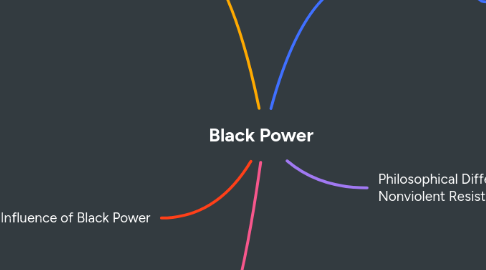
1. Black Power Communities
1.1. SNCC (Student Non-Violent Coordinating Committee)
1.1.1. Turned towards black power approaches after 1966 (influence of their leader Stokely Carmichael)
1.2. The Black Panthers
1.2.1. Formed in Oakland in 1966
1.2.1.1. Key founders: Huey Newton and Bobby Seale
1.2.1.2. Formed for self-defense purposes against police brutality
1.2.1.2.1. Panthers would carry guns legally and openly to protect their community
1.2.1.3. Community uplift programs
1.2.1.3.1. Free breakfast programs
1.2.1.3.2. Free health care programs
1.2.1.3.3. Programs for better access to housing and welfare benefits for those in poverty
2. Influence of Black Power
2.1. Encouraged black people to feel proud of their blackness
2.2. Encouraged black people to form organizations that would uplift their communities
2.3. Huge cultural influence on music, literature, and fashion
3. Limitations of Black Power
3.1. Strong divisions with nonviolent elements of the civil rights movement
3.1.1. Which were intensified by the press
3.2. Faced intense persecution from law enforcement and the FBI
3.3. Intensity of message alienated potential allies who could not hear it
4. Influences
4.1. Malcolm X and the Nation of Islam
4.2. Black Nationalism
4.2.1. Marcus Garvey
5. Philosophical Differences with Nonviolent Resistance
5.1. :flag_red: Malcolm X says "I am for violence if non-violence means we continue postponing a solution to the American black man's problem just to avoid violence."
5.1.1. Not violence for violence's sake
5.1.2. Violence can be used for SELF-DEFENSE
5.2. After the Birmingham bombing (1964) more black people became sympathetic to this idea of using violence in self-defense
5.2.1. Younger activists for racial justice wanted a more direct and confrontational approach (as different from the nonviolent approach of MLK)
5.3. Uprisings (1965-1967)
5.3.1. Large wave of uprisings in Northern cities
5.3.1.1. Caused by segregation (in housing and economic opportunity)
5.3.1.2. And by police brutality against black people
